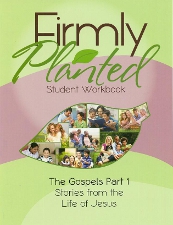The Firmly Planted family Bible study series consists of four Bible study courses that can be used by the entire family. The first two, The Books of Moses, Part 1 and Part 2, cover Genesis 1:1 through Numbers 14. The second set of courses, The Gospels: Stories from the Life of Jesus, Part 1 and Part 2, draw from all four gospels to cover from the Annunciation through the Resurrection. This sequence of studies covers foundational concepts such as the nature of God, the nature of man, the Fall, the promise of redemption, the patriarchs of the Old Testament, God’s mercy and justice, and God’s plan of redemption and its fulfillment in Jesus.
Each course has a Family Study Guide and a Student Workbook. While you can purchase each guide and workbook separately, the sets that include the guide and workbook for each course are the most economical. You can also purchase print or digital (PDF) editions.
While the Family Study Guides are black-and-white books, the Student Workbooks for the first two courses on The Books of Moses are 8 ½ x 11 spiral-bound books that are printed in full color. Workbook pages are unusually heavy and are likely to be very durable. Workbooks have activity pages that target various age groups. No student will complete all of them. The idea is that you will photocopy the pages that you plan to use for each of your children. However, at that point, it means that the beautiful color pages might be printed in black and white unless you splurge on color copies. Consequently, you might do just as well or better with the PDF version, printing out only those pages you want. You can still print PDF pages in color if you choose to do so.
Both Family Study Guides and Student Workbooks for The Gospels, Parts 1 and 2, are available only in digital editions at this time.
Lessons are presented primarily from each Family Study Guide, with lessons for four days per week. Lessons are always based on passages from Scripture, working through the “story” of the Bible in order. Each week’s lessons include memory verses for both younger (ages 4 through 11) and older children. Family Study Guides also have presentation stories that are written in a very personal and engaging style. Interspersed with these are discussion questions. Both presentations and questions can easily be used directly from the book without prior lesson preparation. While lesson presentations help students understand the scripture passages, they also stress life applications. The very natural style of lesson presentation makes it evident that these courses grew out of the St. Johns’ own family Bible studies with their seven children.
Lessons are reinforced and expanded through activities in each Student Workbook. “Responding to God’s Word” activities ask students to write out what they have learned from a particular passage. Students might have charts to complete or a question to answer. They might draw pictures of key events in one of the Bible stories. In recurring activities, Professor Theo Logy takes children deeper into the study of the Bible—both its content and its structure. (Beginning with the second course, the professor sometimes introduces students to theological concepts, such as soteriology.)
Coloring pages plus crossword puzzles, mazes, word searches, coded messages, and other puzzle activities reinforce keywords and themes. Some are designed for younger students and some for older.
Copy work is provided for younger students while older students complete journal activities. “Write about it” activities introduce the Fruit of the Spirit. Nature study activities encourage students to get outside and observe God’s marvelous creation. Map work uses maps specially produced by Knowledge Quest for Firmly Planted courses. These include assignments for different age groups. “Upper Class” assignments take older students to a deeper level with expanded Bible studies and writing assignments.
The Student Workbook activities change slightly from course to course, adding even more activities than those I have described. There are plenty of activities appropriate for all ages, and some of these are heavily illustrated with delightful artwork.
Family Study Guides do not prescribe which activities to use each day. That is left for parents to determine since children will always be working at an unpredictable mixture of grade levels. This is the part of the course that will take some pre-planning to figure out which activities to use on which days. Older students should be able to complete their activities on their own while younger children will need varying levels of assistance, but these courses should still be easy for parents to use.
These courses are very new. I spotted little problems in the first course’s Family Study Guide—missing verses in the first Scripture reading and lack of clarity on the location of the lesson material to be read on Day 4 of the first week on p. 10. Also, the first course uses scripture from five different versions of the Bible, while the other three courses have settled on only the English Standard Version. It seems to me that the St. Johns were developing their conventions and lesson style at the beginning. The Family Study Guides seem to become clearer and more comprehensive, while the depth and quality of the material also seem to improve as they progress through the four courses.
The course content is non-denominational Protestant and should be suitable for most Christian families. While these courses can be used in co-op groups, they are ideally suited for families whether they are homeschooling or not. The variety of activities should keep both younger and older children engaged in the lessons. Moreover, you can complete the core lesson together in a relatively brief period each of the four days per week, and the activities can be selected to fit your own family’s schedule. I love the flexibility.








